
by Judy Biss | Sep 22, 2017

Cotton is largely self-pollinating but attractive to bees. Pollination by bees can increase seed set per boll. Photo by Judy Biss
“The happiness of the bee and the dolphin is to exist.
For man it is to know that and to wonder at it.”
Jacques Yves Cousteau
Bumble bees are among the most recognizable types of insects. They are large, colorful, and a wonder to watch. They’re also popularized in media, cartoons, and clip-art images, but beyond the popular images, bumble bees are worthy of our attention as important pollinators of both native plants and agricultural crops. They are one of hundreds of pollinating bees that are critical to the abundance of our native lands, wildlife, and also our food supply. Protection of pollinators has received national recognition and many programs are now geared towards pollinator conservation.
Why is Pollinator Protection Important?
According to the UF/IFAS publication Minimizing Honey Bee Exposure to Pesticides:
The western honey bee is conceivably the most important pollinator in Florida and American agricultural landscapes. The honey bee is credited with approximately 85% of the pollinating activity necessary to supply about one-quarter to one-third of the nation’s food supply. Over 50 major crops in the United States and at least 13 in Florida either depend on honey bees for pollination or produce more abundantly when honey bees are plentiful.
And:
“Growers also use other managed bees species, such as the bumble bee to provide field and greenhouse crop pollination services. Additionally, there are more than 315 species of wild/unmanaged bees in Florida that play a role in the pollination of agricultural crops and natural and managed landscapes. These include mining bees, mason bees, sweat bees, leafcutter bees, feral honey bees, and carpenter bees, among others.”
Pollinator Protection was formally recognized at the federal level in 2014 when the President of the United States signed an official memorandum entitled: Creating a Federal Strategy to Promote the Health of Honey Bees and Other Pollinators which outlines specific steps to increase and improve pollinator habitat. These steps are geared towards protecting and restoring populations of not only honey bees, but native bees, birds, bats, and butterflies; all of which are vital to our nation’s economy, food production, and environmental health.
Bumble Bee Biology and Ecology
There is much to learn about these fascinating insects. Here are some facts to feed your curiosity. Additional resources are listed at the end of this article.
- Bumble bees belong to the genus Bombus within the family Apidae. As such, they are related to honey bees, carpenter bees, cuckoo bees, digger bees, stingless bees, and orchid bees.
- There are about 50 species of North American bumble bees.
- Bumble bees are social and form colonies like honey bees do, but bumble bee colonies are smaller (50 – 500 individuals) and their colonies only last one season.
- Bumble bees generally make their nests in the ground using abandoned rodent cavities or under old tree roots, etc.
- Each spring, a mated queen emerges from winter hibernation and finds a suitable underground cavity. She begins collecting nectar and pollen and laying eggs to build her colony.
- By late summer and into fall, the only surviving member of the colony are new queens.
- These queens mate and then they hibernate during winter 2-5 inches deep in the soil. The following spring these queens emerge and start new colonies, repeating the annual cycle.
- Bumble bees are adapted to a wide range of environmental conditions and can forage in cooler, cloudier, and wetter weather better than other bees. Because of this adaptation, they are generally the first bees out in early spring and the last bees out in the fall.
- Since bumble bees are adapted to a wide range of environmental conditions, they are also able to feed on a wide variety of flowering plants.
- Bumble bees do make honey, but only enough to feed the colony during bad weather when they are unable to go out and forage.
- Bumble bees, like the blueberry bee collect pollen from certain flowers using a unique behavior called “buzz pollination,” or “sonication.” This behavior is not found in European honey bees. Some plants, blueberries for example, hold tightly to their tiny pollen. Bumble bees and blueberry bees grab the flower structure and powerfully vibrate their wings while holding onto the flower. Their whole body vibrates and literally shakes the pollen lose from the flower.
- Besides blueberries, other commercially important food crops that benefit from “buzz pollination” include, tomatoes, peppers, and cranberries.
- Bumble bees are so effective at pollinating important food crops that they are raised commercially and sold to greenhouses to pollinate produce such as tomatoes, peppers, and strawberries.
Create Your Own Pollinator Pasture
You can help increase the abundance and health of bumble bees, other native pollinators, and honey bees by creating nectar and pollen rich bee pastures. These pastures can be filled with annual plants, which grow from seed each year, perennial plants, which return and spread on their own each year, various flowering shrubs and trees, or any mixture of above. You can also manage existing natural areas and woodlands by employing recommended prescribed fire regimes, non-native invasive plant control, and other practices to encourage a diversity of native pollinator plants.
The ideal bee pasture is one in which flowers are blooming as continuously as possible throughout the year. Research shows bees thrive best in open sunny pastures that are as large as possible, with a diversity of plants types. While flowering shrubs along woodland edges are well used by bees, a bee pasture that is allowed to become dominated by trees and shade will become less attractive to bees. A dedicated, open, sunny pasture having nectar and pollen plant diversity is best. Just as with any field you intend to plant, the first step is to collect a soil sample for analysis of existing nutrients and pH levels. (For more information on soil samples read the article Soil Test First!
Pollinator Plant Types
There are many plants that provide nutritious nectar and pollen for north Florida’s pollinators. Some examples of plants which are good pollinator food sources are maple trees, redbuds, poplars, gallberries, blackberries, palmettos, partridge pea, mint, thistles, goldenrod, asters, tickseeds, sunflowers, squash, melons, and clovers. If you purchase a bee pasture blend from a seed company, make sure it is suited for growing in north Florida and does not contain noxious, invasive, weedy plant species. The Florida Exotic Pest Plant Council maintains a listing of documented invasive plants here: List of Invasive Plant Species.
Summary and Resources
The business, biology, and botany of pollination is fascinating and critical to sustainable and diverse food production in Florida and the United States. Bumble bees are just one of the many native pollinators that frequent our forests, fields, and gardens. Consider turning your fallow lands or backyards into productive bee pasture and reap a sweet harvest.
For more information please see the resources used for this article below:
by Shep Eubanks | Sep 22, 2017

Big Buck on the Move – Photo Credit Shep Eubanks, UF/IFAS
About this time each year the minds of sportsman and wildlife aficionados turn towards the planting of wildlife food plots for use by wildlife in fall, winter , and early spring. There are many factors to consider when planting a fall food plot if you want to be successful in the endeavor. Food plots can be an effective method of providing food sources for game birds, deer, rabbits, raccoons, and other species. The size of food plots vary according to landowner preferences and the requirements of the target wildlife species, but usually they are a minimum of 1/2 to 1 acre in size, with a maximum of 5 acres.
Location is a an important consideration when planning the plot as the most effective plots typically are located adjacent to sanctuary or escape cover that provides security for wildlife. Food plots that meander along edges of of two or there converging types of cover, such as the edge created where pine plantations, hardwood bottoms, and agricultural fields intersect, are very attractive to wildlife and provide natural travel corridors, in addition to providing a high nutrition food source.
Successful planting of your crop begins with soil sampling. Having the proper pH in your food plot is of paramount importance. A pH of 6.5 is ideal for winter annual grasses and legumes in North Florida. As an Ag Agent I have seen more food plot disasters because a landowner did not take time to soil test than any other reason. The soil test will also guide you in applying proper fertilization to optimize productivity of your food plots. Food plots are expensive to establish and you want to avoid needless mistakes such as poor fertility that will yield poor results.
Preparation of a good seedbed is also very important as is selection of seeds that are adapted to our area. UF/IFAS has developed some excellent resources that will assist you in selecting forages that do well in our area such as, A Walk on the Wild Side: 2013 Cool-Season Forage Recommendations for Wildlife Food Plots in North Florida. Another Excellent reference is Establishing and Maintaining Wildlife Food Sources.
Now is the time to make your preparations for planting your successful cool season food plot here in North Florida! hopefully you will have the experience of seeing and enjoying wildlife as pictured in photo 2 and photo 3!
For more information on planting successful food plots this fall, contact your local UF/IFAS Extension office.

Photo 2. Nice Buck grazing woods edge food plot in North Florida Photo Credit – Shep Eubanks, UF/IFAS
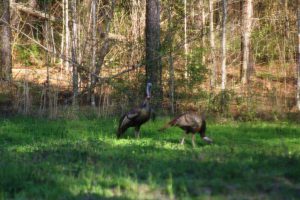
Photo 3. Gobbler and Hen Standing in Crimson Clover
Photo Credit – Shep Eubanks, UF/IFAS
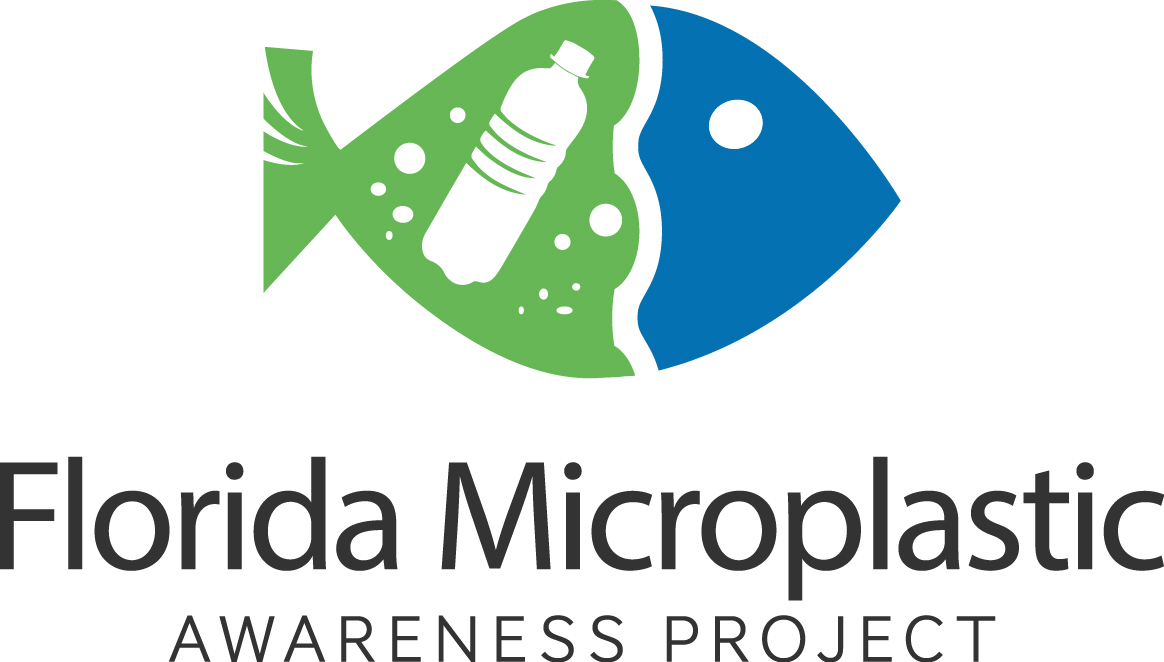
by Rick O'Connor | Sep 22, 2017
For almost 40 years, the Ocean Conservancy has held the International Coastal Cleanup in September. Across the planet hundreds of thousands of volunteers clean marine debris from their shorelines. The data collected is used by local agencies to manage this problem; such as discontinuing the use of pull tops from aluminum cans. In the last couple of years researchers are trying to make the public aware of another form of plastic most know little about – microplastics.
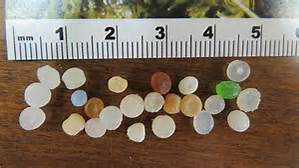
“Nurdle” are primary microplastics that are produced to stuff toys and can be melt down to produce other products.
Photo: Maia McGuire
Microplastics are defined as pieces measuring 5 mm in length or smaller. These can be large pieces of common plastics that been degraded by sea and sun. They can be small pellets called nurdles that are melted down and poured into molds to produce common plastic products or used to stuff toys. They can also be small beads used as fillers in personal care products, such as toothpaste. Those that are manufactured at this size are called primary microplastics; those that degrade to this size are secondary microplastics.
How Do They Find Their Way to Local Waterways?
The sources of secondary microplastics is obvious. We either intentional or unintentionally discard our waste into the environment. According to data collected by the local nonprofit group Ocean Hour, cigarette butts are the number item collected during weekly cleanups. Many are not aware that much of the material in a cigarette butt is actually plastic fibers, and many butts are tossed to the ground intentionally. Adhered to these fibers are the products of smoke we are concerned with in our own health – tar, nicotine, and ethylphenol.
Ocean Hours data show other forms of plastics (bags, wrappers, cups, bottles, and caps) are very common. These items are discarded directly, or indirectly, into the environment and eventually end up in our bays and oceans – “all drains lead to sea kid”. Here they are eventually broken down. Some scientists believe all the plastic ever produced is still in the sea, continuing to breakdown smaller but never really going away. I viewed a webinar within the last year where a researcher from the west coast was discussing the “great plastic island” in the Pacific. She showed a photo from the location and you did not really see a lot of large plastic drifting. However, a plankton tow revealed large amounts of microplastics.
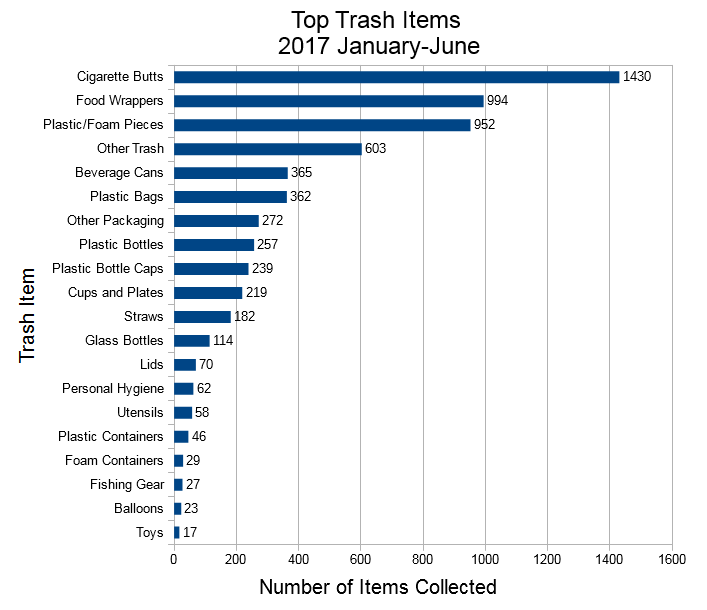
Marine debris collected by Ocean Hour during the first half of 2017.
Image: Ethan Barker
Less common are the primary microplastics… but they are there. According to our monitoring in the Pensacola Bay Area, they make up about 20% of the microplastics found. When we wash our faces, or brush our teeth, with plastic filled products these microplastics are washed down the drain to the local sewer treatment facility. Here they remain on the surface of the water that is being treated and are eventually discharged into wetlands, or directly into a water body.
Are These Microplastics Having a Negative Impact on the Environment?
Locally, we are monitoring 22 stations. We are finding an average of 9 pieces of microplastic / 100ml of sample (little more than 3 ounces). This equates to a lot of microplastic in our bay. Science does know that these are small enough to be swallowed by zooplankton in our water column. It plugs their digestive tract and gives them the sensation of being full. Thus, they stop eating and starve. A decline zooplankton, a key component of most aquatic food chains, could affect economically important members higher up the food chain.
Laboratory studies show it may be affecting lower on the food web. When subjected to water containing microplastics, the microalgae Chorella reduced its uptake of carbon dioxide; thus reducing photosynthesis.
In larger species, microplastics have been found in the tissue of some bivalves, including those commercially harvested for human consumption. There is little evidence connecting health related problems of either the bivalve or the human consumer, to microplastic consumption – but there is concern.
There is evidence showing chemical contaminants adhere to the plastics and can increase their concentrations 1 million times. Swallowing plastics with high concentrations of Polychlorinated biphenyls (PCBs), polycyclic aromatic hydrocarbons (PAHs), and DDT (all of which have been found on microplastics) could be problematic.
There is also concern of bioaccumulation of these contaminants as they move through the food chain, but little evidence that it does. There is also little research on the leaching of toxic products from these plastics and their impacts. In his recent publication on the status of water quality in Pensacola Bay, Dr. Mike Lewis agrees that more attention needs to be paid to microplastics.
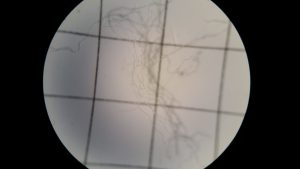
These microfibers are from the inside of cigarette butts and a common form of microplastic in our waters.
Photo: Maia Mcguire
What Can We Do About the Microplastic Issue?
- Cut back on your use of plastics. Easier said than done, our world is full of plastic, but there are a few things you can do:
- a) choose not to use straws when eating out.
- b) purchase a good water bottle and take it with you. Many locations where we purchase coffee or fountain drinks you can use this bottle instead of their foam or plastic cups.
- Change your habits and product choices.
Personal care products with microplastics will have polyethylene on the ingredient label; if it does – choose a different one. There is a website that lists many of these products.
Http://householdproducts.nlm.nih.gov.
- If possible, wear clothing made of natural fibers.
Being aware of the microplastic problem is the first step in correcting it.
References
Unpublished data analyzed by the Escambia County Division of Marine Resources and Florida Sea Grant.
Yang, Y., I.A. Rodriguez-Jorquera, M. McGuire, G.S. Toor. 2015. Contaminants in the Urban Environment: Microplastics. Electronic Data Information Source (EDIS). 6 pages. http://edis.ifas.ufl.edu/pdffiles/SS/SS64900.pdf.

by Rick O'Connor | Sep 15, 2017
In the late 1980’s a few exotic lionfish were found off the coast of Dania Florida. I do not think anyone foresaw the impact this was going to have. Producing tens of thousands of drifting eggs per female each week, they began to disperse following the Gulf Stream. First in northeast Florida, then the Carolina’s, Bermuda, the Caribbean, and eventually the Gulf of Mexico. The invasion was one of the more dramatic ones seen in nature.
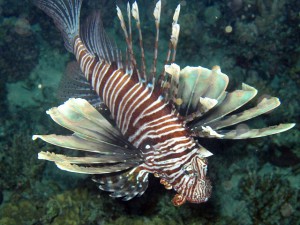
The Invasive Lionfish
Lionfish are found on a variety of structures, both natural and artificial, and are known from shallow estuaries to depths of 1000 feet in the ocean. They are opportunistic feeders, engulfing whatever is within their range and fits in their mouths, and have few predators due to their neurotoxicity spines. These fish are well-designed eating machines with a high reproductive rate, and perfectly adapted to invading new territories, if they can get there.
And they got here…
Like so many other invasive species, humans brought them to our state. Some arrive intentionally, some by accident, but we brought them. Lionfish came to Florida intentionally as an aquarium fish. Beautiful and exotic, they are popular at both public aquariums and with hobbyists… Then they escaped.
So what now?
What impact will these opportunistic fish have on the local environment? On the local economy?
This is, in essence, the definition of an invasive species. The potential for a negative impact on either the ecosystem or local fishing is there. We now know they are found on many local reefs, in many cases the dominant fish in the community. We know they can produce an average of 25,000 fertilized per female per week and breed most of the year. We also know they consume a variety of reef fish, about 70 species have been reported from their stomachs.
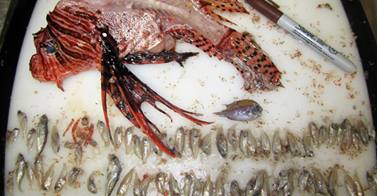
Over 70 species of small reef fish have been found in the stomachs of lionfish; including red snapper.
Photo: Bryan Clark
However, what impact is this having on local fisheries?
Well, we do know there have been more reports of fishermen catching them on hook and line. We also know that scientists are examining the DNA of their stomach content that cannot be identified visually, and some of the results indicate commercially valuable species are on the menu.
Area high school students are now conducting dissections using this same methodology. Under the direction of Dr. Jeff Eble, over 900 area high school students examined the stomach contents of local lionfish last year. Students from Escambia, Gulf Breeze, Navarre, Pensacola, Washington, and West Florida high schools – along with Woodlawn Middle School – identified 16 different species in lionfish stomachs. Of economic concern were snapper; 42% of the prey identified were Vermillion Snapper – 4% were Red Snapper.
Though the consumption of non-commercial species can affect the population of commercial ones, the direct consumption of commercial species is concerning. The commercial value of Vermillion Snapper landed in Escambia County in 2016 was about $800,000 (highest in the state).
This year two more high schools will participate in the dissection portion of this project; those being Tate and Pine Forest. These students need lionfish and we are seeking donations from local divers to help support this project. If interested in helping, please contact me at roc1@ufl.edu or (850) 475-5230.
References
Dahl, K.A. W.F. Patterson III. 2014. Habitat-Specific Density and Diet of Rapidly Expanding Invasive Red Lionfish (Pterois volitans), Populations in the Northern Gulf of Mexico. PLOS ONE. Vol 9 (8). Pp. 13.
FWC Commercial Landing Summaries. 2017. https://public.myfwc.com/FWRI/PFDM/ReportCreator.aspx.
by Rick O'Connor | Sep 15, 2017
I recently saw a photograph of an American Alligator (Alligator mississppiensis) crossing Perdido Key Drive on a heavy rain day. This encounter would surprise some, and unnerve many. The majority of the nuisance wildlife calls I receive are for snakes. I have never received a call for an alligator but no doubt, my colleagues in central and south Florida have. They certainly will with the landfall of Irma. Just as humans relocate for storms, wildlife does as well. High, dry ground is a need for all, and as our friends return to their homes after the storm, they will no doubt encounter creatures in the debris that can be a bit unnerving.

Alligator basking on a shoreline; photo: UF/IFAS Communications
“Nuisance” is in the eye of the beholder. Defined by the Merriam-Webster dictionary as being annoying, unpleasant, or obnoxious, a nuisance species is one we would rather not have in our yard. Snakes are one of those. Most of the people who call about snakes wish them no harm; they just do not want them on their porch or in their pool. Venomous snakes in particular raise anxiety levels, especially when children or pets are around. Though we do not get many calls on alligators, the feeling a homeowner would have if they found one in their driveway would be the same.
There were no calls on the alligator on Perdido Key. Actually, not everyone believed the photo to be legit. I cannot verify it, but I did receive a call earlier this summer when an American alligator was found swimming and basking on a Gulf beach in Navarre and later near Ft. Pickens. Though not as common as they are in central and south Florida, alligators do live here and they are found on our barrier islands. Though encounters with them are rare, how should a homeowner deal with this potential nuisance? When I give a program on snakes I typically go over four points. Let us go over the same with the alligators.
Is it venomous or not?
Obviously, this is not a question here – no crocodilian is venomous. They do have bacteria in their mouths that have caused problems for some who have survived an attack, but there is no venom. However, in south Florida identification is still important because there is more than one crocodilian roaming the landscape. The American Crocodile (Crocodylus acutus) is a native species found in coastal waters of south Florida, the northern reach of its range. The Speckled Caiman (Caiman crocodylus) is an exotic species from Central and South America that is now found in freshwater canals and lakes of southeastern Florida. It is likely that post Irma cleanup will include encounters with these two. However, this is not likely for the panhandle – our winters are too cold.
How do I avoid encounters?
Generally encounters with nuisance wildlife occur for one of two reasons; (a) we have moved into their habitat or (b), they have come to us.
With the population of Florida growing at an ever increasing rate, currently 21 million people and a growth rate of 1.77%, development continues to expand into habitat where these animals have remained out of our sight for some time. As we continue to move into these habitats, encounters with nuisance wildlife will increase. They will be forced to visit our yards and pools. It is no different with bears.
In other cases we, either knowing or unknowingly, provide food and shelter for them. Predators tend to select the easiest prey to kill, the ones that take the less energy. Human development tends to provide habitat for vermin, such as rats, in concentrated areas. This makes hunting for predators, such as snakes, bears, and alligators, much easier – and they will take advantage of this.
With alligators, (a) is more problematic than (b). Alligators have a natural fear of humans and do not typically seek us out looking for easy prey. They seem to prefer to live and hunt away from us. However, feeding alligators changes this and thus, it is a felony to do so in our state. In 2015, the state legislature developed a tiered penalty system for assessing fines and charges. As we continue to develop in areas where alligators live, it will be harder to avoid encountering them.
What do I do if I encounter one?
The general nature of wildlife is reacting to predators, prey, reproduction, and shelter. Alligators are top predators and feed on a variety of species. They are opportunistic hunters, selecting prey they can easily swallow and are relatively easy to catch. Much of these are smaller animals. If the opportunity to make a large kill presents itself, they will – however, they will drown the creature and leave it underwater to soften the carcass so they can swallow.
The method of capture usually involves lying still and waiting for prey to move within range. If encountering an alligator the questions that come to mind are: (1) am I within range? (2) are we near water? – remember they need to submerged large prey. Keep in mind that small children and pets are easier prey and care should taken when in alligator habitat.
Resources provide the following suggestions if an encounter occurs:
- They have a nature fear of humans and will try to retreat. This is true. Provide an avenue of escape for the animal. Do your best not to corner it. Remember it may react to pets and children as prey and could approach.
- If they hiss, they are warning you that you are getting too close and they are feeling threatened. Back away slowly. Sudden movements could be misinterpreted and they may defend themselves by attacking.
- Keep in mind they are fast moving for several yards, so do not think of them as slow and lethargic.
- Females guarding a nest may attack. They will charge to drive you off but typically return to the nest once you have moved to a safe distance (safe in their minds). Alligators build nests of leaf litter above ground in quiet water areas within their range. You may encounter one while hiking along shore. Avoid these nesting areas.
Alligator basking on the Escambia River; photo: Molly O’Connnor
And what if I’m bitten?
This question makes sense if you are talking snakes. With snakes, you are bitten and the snake withdraws. So the question comes up, now what? Not so much with alligators. Though alligators tend to feed on smaller and softer prey, as they increase in age and size, their skull structure adjust to where they can crush turtle shells and mammal bones. Forces have been recorded between 12 and 9452 Newtons, depending on age. When they bite they do not typically withdraw, but rather will drag you into water. Do whatever you can to avoid being dragged into water. Since 1948 there have been 388 alligator attacks, 24 were fatal. That averages to 6 attacks/year statewide and about 1 fatality every 4 years – so it is not very common. But remember, human development is encroaching and we will need to learn to live with them as our ancestors did when the animals were more numerous.
In Florida, an alligator is not considered a nuisance unless it is at least 4 feet in length. If you feel there is a nuisance alligator in your neighborhood you can call.
1-866-FWC-GATOR
References
American Crocodile: Species Profile. National Park Service. https://www.nps.gov/ever/learn/nature/crocodile.htm.
Caiman. 2017. Florida Fish and Wildlife Conservation Commission. http://www.myfwc.com/wildlifehabitats/managed/american-crocodile/caiman/.
Erickson, G.M., A.K. Lappin., A.K. Vilet. 2003. The Ontogeny of Bite-Force Performance in American Alligator (Alligator mississippiensis). Journal of Zoology. Vol 260 (3). Pp. 317-327. https://www.cambridge.org/core/journals/journal-of-zoology/article/the-ontogeny-of-bite-force-performance-in-american-alligator-alligator-mississippiensis/150E92D79C5FAEB821DDBF563888E773. P
Florida Population 2017: Demographics, Maps, and Graphs. 2017. World Population Review. http://worldpopulationreview.com/states/florida-population/.
Merriam-Webster Online Dictionary. https://www.merriam-webster.com/dictionary/nuisance.
Statewide Nuisance Alligator Program. 2017. Florida Fish and Wildlife Conservation Commission. http://myfwc.com/wildlifehabitats/managed/alligator/nuisance/.
Swiman, E., M. Hostetler, S. Webb Miller, M. Main. 2017. Living with Alligators: A Florida Reality. University of Florida Institute of Food and Agricultural Science Extension Electronic Data Information Source (EDIS) publication WEC203.
http://edis.ifas.ufl.edu/pdffiles/UW/UW23000.pdf.
Texas Parks and Wildlife. If You See An Alligator. https://tpwd.texas.gov/huntwild/wild/species/alligator/safety/index.phtml.
Wildlife Feeding Rules and Penalties. 2017. Florida Fish and Wildlife Conservation Commission. http://myfwc.com/news/resources/fact-sheets/feeding-rules-and-penalties/.
















